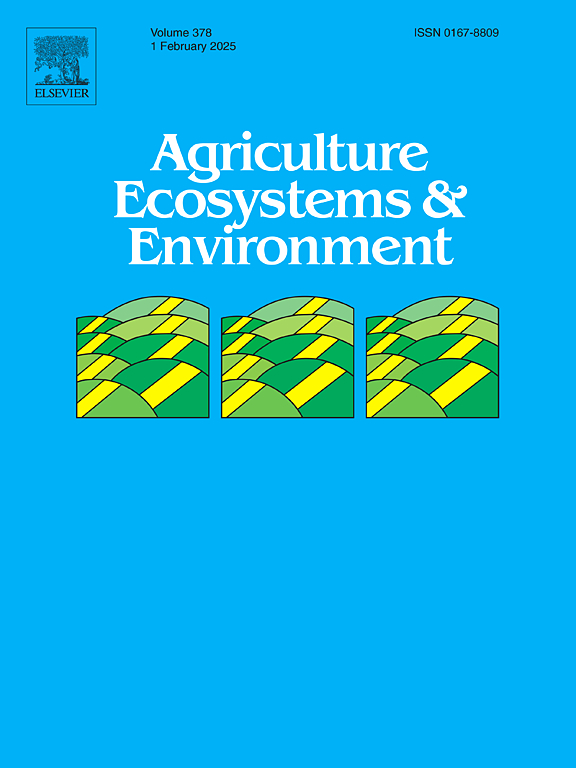生物质投入推动农艺管理对土壤健康的影响
IF 6
1区 农林科学
Q1 AGRICULTURE, MULTIDISCIPLINARY
引用次数: 0
摘要
土壤健康(SH)是确保粮食生产系统可持续性的关键因素,许多保护和再生措施被认为是管理土壤健康的有效策略。尽管这些措施的重要性已得到公认,但其多方面的影响往往会产生混淆效应,而且依赖于对农艺措施的通用分类往往不足以描述土壤健康的驱动因素。我们主张从以标签为中心的方法向以过程为基础的方法转变。我们的研究强调了地上生物量循环的关键作用,它是评估农艺管理措施对碳平衡的潜在影响的指标,因此也是SH的指标。根据乌拉圭对潘帕斯地区莫利土进行的三项长期实验所获得的土壤物理、生物和化学 SH 数据,我们(i)提出了通过生物量输入评估 SH 的重要性的定量证据,(ii)说明了所建议的框架对评估该地区不同土地管理方案的适用性。在综合土壤的物理和生物 SH 指数的观测变化中,管理引起的地上生物量输入变化占 50%,并有助于解释管理措施的不一致效果。要将 SH 指数提高 10 个点,需要增加超过 5000 万公顷-¹的生物量投入。根据这一概念,可以通过缩小产量差距和多年加强耕作序列来大幅提高 SH 指数。增加作物多样性、整合多年生作物和覆盖作物或减少耕作等做法在促进 "可持续农业 "方面的益处,部分取决于其提高生物量生产的能力。这种细致入微的理解强调了将农艺策略与驱动 SH 动态的基本过程相结合的重要性。本文章由计算机程序翻译,如有差异,请以英文原文为准。
Biomass inputs drive agronomic management impacts on soil health
Numerous conservation and regeneration practices are recognized as effective strategies in the management of soil health (SH), a critical factor for ensuring the sustainability of food production systems. Despite their acknowledged importance, the multifaceted impacts of these practices often lead to confounding effects, and reliance on generic categorization of agronomic practices often falls short in portraying the drivers of SH. We advocate for a paradigm shift from a label-centric approach to one rooted in processes. Our study underscores the pivotal role of aboveground biomass cycling as an indicator for assessing the potential of agronomic management practices to instigate shifts in carbon balances, and, consequently SH. Drawing on soil physical, biological, and chemical SH data from three Uruguayan long-term experiments on Pampas region Mollisols we (i) present quantitative evidence of the importance of evaluating SH through biomass inputs, and (ii) illustrate the applicability of the proposed framework for evaluating different scenarios of land management for the region. Management-induced variations in aboveground biomass inputs accounted for 50 % of the observed changes in a composite soil's physical and biological SH index and helped explain the inconsistent effect of management practices. Raising the SH Index by ten points required an increase in biomass inputs of over 50 Mg ha⁻¹. Based on this concept, substantial enhancements in SH can be made by narrowing yield gaps and intensifying cropping sequences over many years. The benefits of practices such as increased crop diversification, integration of perennial and cover crops, or reduced tillage in promoting SH depend in part on their ability to augment biomass production. This nuanced understanding underscores the importance of aligning agronomic strategies with the fundamental processes driving SH dynamics.
求助全文
通过发布文献求助,成功后即可免费获取论文全文。
去求助
来源期刊

Agriculture, Ecosystems & Environment
环境科学-环境科学
CiteScore
11.70
自引率
9.10%
发文量
392
审稿时长
26 days
期刊介绍:
Agriculture, Ecosystems and Environment publishes scientific articles dealing with the interface between agroecosystems and the natural environment, specifically how agriculture influences the environment and how changes in that environment impact agroecosystems. Preference is given to papers from experimental and observational research at the field, system or landscape level, from studies that enhance our understanding of processes using data-based biophysical modelling, and papers that bridge scientific disciplines and integrate knowledge. All papers should be placed in an international or wide comparative context.
 求助内容:
求助内容: 应助结果提醒方式:
应助结果提醒方式:


